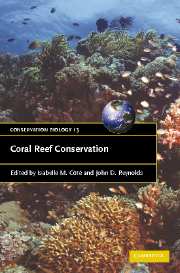Book contents
- Frontmatter
- Contents
- List of contributors
- Foreword
- Preface
- Part I Setting the stage
- Part II Uses and abuses: ecological and socio-economic issues
- Part III The way forward: tools and approache
- 9 New approaches to estimating recent ecological changes on coral reefs
- 10 Assessing the effectiveness of marine protected areas as a tool for improving coral reef management
- 11 Environmental impact assessment for coral reefs: advocating direct protective approaches
- 12 Time for a third-generation economics-based approach to coral management
- 13 Collaborative and community-based conservation of coral reefs, with reference to marine reserves in the Philippines
- 14 Education as a tool for coral reef conservation: lessons from marine protected areas
- 15 Adaptive institutions for coral reef conservation
- 16 Coral reef restoration with case studies from Florida
- 17 Redesigning coral reef conservation
- 18 Coral reef coda: what can we hope for?
- Index
- Plate section
- References
17 - Redesigning coral reef conservation
Published online by Cambridge University Press: 05 June 2012
- Frontmatter
- Contents
- List of contributors
- Foreword
- Preface
- Part I Setting the stage
- Part II Uses and abuses: ecological and socio-economic issues
- Part III The way forward: tools and approache
- 9 New approaches to estimating recent ecological changes on coral reefs
- 10 Assessing the effectiveness of marine protected areas as a tool for improving coral reef management
- 11 Environmental impact assessment for coral reefs: advocating direct protective approaches
- 12 Time for a third-generation economics-based approach to coral management
- 13 Collaborative and community-based conservation of coral reefs, with reference to marine reserves in the Philippines
- 14 Education as a tool for coral reef conservation: lessons from marine protected areas
- 15 Adaptive institutions for coral reef conservation
- 16 Coral reef restoration with case studies from Florida
- 17 Redesigning coral reef conservation
- 18 Coral reef coda: what can we hope for?
- Index
- Plate section
- References
Summary
INTRODUCTION
Coral reefs are the most diverse shallow water marine ecosystem but in many parts of the world they are becoming degraded rapidly by a combination of human stresses and climate change (Birkeland, 1997 Wilkinson, this volume). Recent analyses suggest that at least 58% of corals reefs worldwide are directly threatened by human activities (Bryant et al., 1998). Major stressors impacting reef habitats include sediment and nutrient pollution from coastal development, land clearing and agriculture, over- fishing, pest and disease outbreaks, and global warming (Polunin and Roberts, 1996 Birkeland, 1997 Hoegh- Guldberg, 1999).
An estimated 20%of reefs have already been destroyed (Wilkinson, this volume), while less than a half of the 16% of reefs seriously damaged by global warming- induced increases in sea- surface temperatures in 1998 have recovered (Wilkinson, 2000). Where reefs are exposed to multiple stresses recovery could be slow or may not occur (Connell, 1997). In the Caribbean,; Gardner et al. (2003) have shown a region- wide decline in coral cover from 50% to 10% between 1977 and 2001. Spalding and Grenfell (1997) estimated that there are 20 000 km2 of reefs in the Caribbean, implying a loss of 8000 km2 of coral in 24 years, or 333 km2 of coral per year. Analyses of fossil records from the Caribbean suggest that recent reef degradation has been unprecedented over the last 100 000 years (Jackson et al., 2001 Wapnick et al., 2004 Precht and Aronson, this volume).
- Type
- Chapter
- Information
- Coral Reef Conservation , pp. 515 - 537Publisher: Cambridge University PressPrint publication year: 2006
References
- 7
- Cited by



